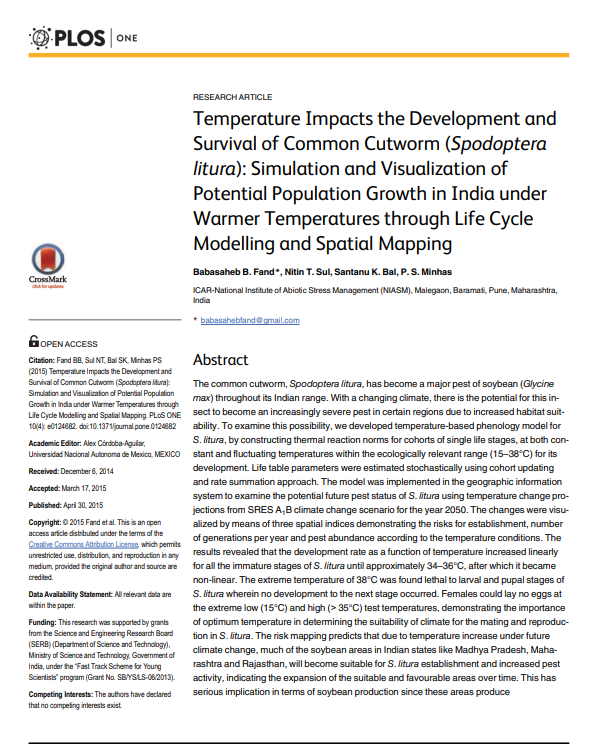The common cutworm, Spodoptera litura, has become a major pest of soybean (Glycine max) throughout its Indian range. With a changing climate, there is the potential for this insect to become an increasingly severe pest in certain regions due to increased habitat suitability. To examine this possibility, we developed temperature-based phenology model for S. litura, by constructing thermal reaction norms for cohorts of single life stages, at both constant and fluctuating temperatures within the ecologically relevant range (15–38°C) for its development. Life table parameters were estimated stochastically using cohort updating and rate summation approach. The model was implemented in the geographic information system to examine the potential future pest status of S. litura using temperature change projections from SRES A1B climate change scenario for the year 2050. The changes were visualized by means of three spatial indices demonstrating the risks for establishment, number of generations per year and pest abundance according to the temperature conditions. The results revealed that the development rate as a function of temperature increased linearly for all the immature stages of S. litura until approximately 34–36°C, after which it became non-linear. The extreme temperature of 38°C was found lethal to larval and pupal stages of S. litura wherein no development to the next stage occurred. Females could lay no eggs at the extreme low (15°C) and high (> 35°C) test temperatures, demonstrating the importance of optimum temperature in determining the suitability of climate for the mating and reproduction in S. litura. The risk mapping predicts that due to temperature increase under future climate change, much of the soybean areas in Indian states like Madhya Pradesh, Maharashtra and Rajasthan, will become suitable for S. litura establishment and increased pest activity, indicating the expansion of the suitable and favourable areas over time. This has serious implication in terms of soybean production since these areas produce approximately 95% of the total soybeans in India. As the present model results are based on temperature only, and the effects of other abiotic and biotic factors determining the pest population dynamics were excluded, it presents only the potential population growth parameters for S. litura. However, if combined with the field observations, the model results could certainly contribute to gaining insight into the field dynamics of S. litura. ILCYM
Temperature Impacts the Development and Survival of Common Cutworm (Spodoptera litura): Simulation and Visualization of Potential Population Growth in India under Warmer Temperatures through Life Cycle Modelling and Spatial Mapping
Citation: Fand BB, Sul NT, Bal SK, Minhas PS (2015) Temperature Impacts the Development and Survival of Common Cutworm (Spodoptera litura): Simulation and Visualization of Potential Population Growth in India under Warmer Temperatures through Life Cycle Modelling and Spatial Mapping. PLoS ONE 10(4): e0124682. https://doi.org/10.1371/journal.pone.0124682
2015-04-30
CROP PROTECTION
Asia
India
journal_article

